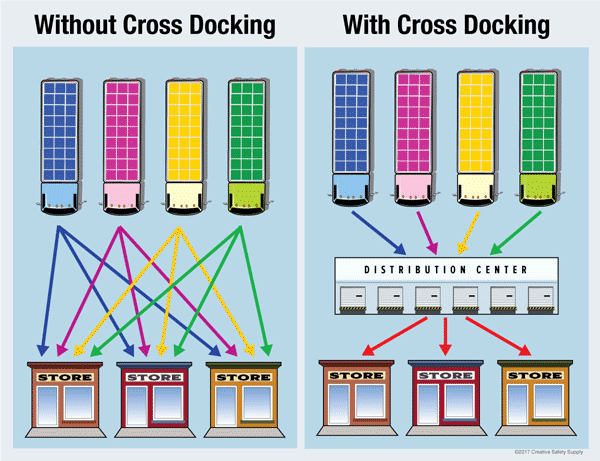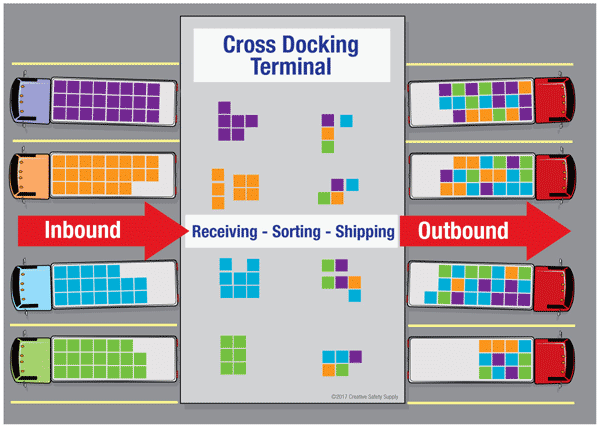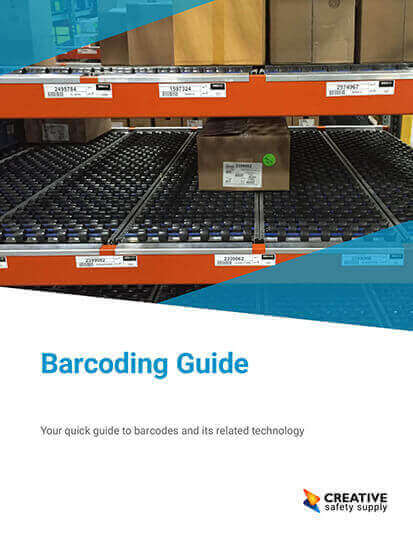
Cross docking is a logistical strategy where products and materials are unloaded from one inbound source (truck, railcar, etc.) and then immediately moved onto outbound transportation with as little storage time as possible. This is desirable because the longer products sit in a warehouse or other storage location, the less overall value they provide.
Avoid Storing Products
Any time a product is stored is time that it is not creating value for the company or the customer. In addition, storage time introduces additional risk. The following are some key reasons why a company should avoid storing products:
- Drop in Value - Products that are kept in storage can potentially drop in value due to changes in demand, aging issues, and more.
- Change in Demand - Demand for most products changes over time and in many cases drops. Products in storage are at risk of becoming undesirable and therefore worth less.
- Damage or Theft - Having products sitting on a shelf in a warehouse leaves them exposed to risk of damage, theft, or other issues.
There are many other reasons why avoiding product storage as much as possible is a good idea. Eliminating waste and risk are important for any company and are the focus of strategies such as 5S.
 Warehousing and Distribution
Warehousing and Distribution
Cross docking is most commonly used as part of a company's warehouse and distribution efforts. Many companies have products brought into a warehouse where they are sorted, consolidated, and then put onto another truck or transport vehicle to go out to a retail outlet. These locations serve as warehouses or distribution centers.
The distribution center can accept large deliveries of products, which are then broken up into groups to be sent out to each individual store that they operate. Major retailers such as Walmart are examples of this type of strategy.
Cross-docking helps simplify the warehousing and distributing of products for many companies. Previously, a company often has to have multiple suppliers or sources bringing each product to their retail store. As you can see in the image below, however, cross docking has all the suppliers bringing products to one central location.
From there, the retailer receives the products, sorts them, and then ships them where they need to go. This gives the retailer much more control over which store is going to get which products.
Advantages
While certainly not the right logistics strategy for every company, it can provide many great benefits when used properly. Some key advantages include:
- Control - Companies get to direct product levels at a much more detailed level. This ensures each retail outlet gets exactly what it needs to meet customer demands, no more and no less.
- Just in Time - Cross docking is often used for just-in-time manufacturing where supplies are delivered where they are needed as they are needed to ensure there is no excess storage of parts or products.
- Lower Warehousing Costs - With this type of distribution strategy in place, there is much less need for warehousing products, which saves companies money.
- Organized - When properly implemented, this strategy can help keep a company's supply line more organized.
- Reduced Labor Costs - With less storage and warehousing, there is less need for people handling the products, which can help drive down labor costs.
Working with Third Party Logistic Companies
Cross-docking often uses third party logistic companies to help implement and manage the system. These companies are experts at streamlining the receiving, sorting, and shipping of products from centralized distribution centers. Many companies use these logistic experts to get their system up and running and then take it over to handle for the long term.
Others simply contract the cross-docking process out. Third party logistic companies can have one distribution center that serves dozens of companies. All the products for each company are sent to this one center, and the logistics company organizes and distributes all these products. This is a very economical way to handle receiving and distribution, especially for small to mid-sized companies that may not need a full facility for themselves.
Cross-Docking Stations Within a Facility
Although primarily used to handle the incoming and outgoing parts, products, and other items for multiple locations, it is also possible to use cross docking stations to help improve efficiency within a single facility.
A cross-docking station can be a specific area within a facility where all parts, products, tools, and other required items are delivered. This station will then go through and sort everything so it is organized and ready to be used when needed. When a specific department within the facility needs something, the station will have it delivered directly to this area.
Improving Facility Efficiency
This can be a very efficient way to keep a workplace more organized. In addition, it can help reduce excess inventory because the one central area will track what is in the facility and what is being used. A facility can make adjustments to the ordering of inventory or other supplies to help minimize the amount they have on hand at any given time.
Another advantage of an internal cross docking station is that it can keep track of a lot of equipment and supplies to reduce the risk of theft or loss. If a department needs to use specific tools for a job, they will have it checked out and the tool will be tracked until it is returned. This process can typically be automated as well to ensure each area has access to what they need, when they need it.

Supplies are brought in to the receiving area, which is typically on one side of the station. This is also where any tools or reusable parts and equipment will be returned after use. On the other side of the station is where individuals or departments will pick up the items they need.
Implementation
Using advanced machines that can read bar codes, QR codes, or RFID tags that are placed on incoming products and then sorting them automatically, for example, is a great way to automate much of the receiving and sorting process. Very advanced facilities, such as those run by UPS, have nearly 100% automation from the time packages are unloaded from one truck all the way through to the point where they are loaded onto an outgoing truck.
Need barcodes?
Our free barcode generator allows you to create custom barcodes readable with any scanner.
Every company will have a different set of requirements, which will require adjustments to the implementation of cross docking. With the right planning up front, however, it is possible to see very significant improvements in efficiency in most companies.
Sources
Similar Articles
- Warehouse Management (Supply Chain Systems + Visual Management)
- Floor Marking Ideas for Warehouses
- Perpetual Inventory System
- Understanding the Principles of Lean Construction
- What is Logistics Management? (Supply Chain)
- Understanding the SIPOC Diagram in Six Sigma
- What is Lean Logistics?
- Understanding the NFPA 704 Diamond Labeling System
- Understanding The 5S Methodology Implementation


